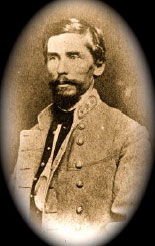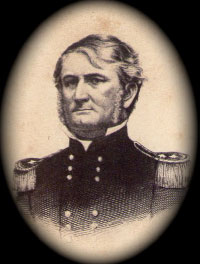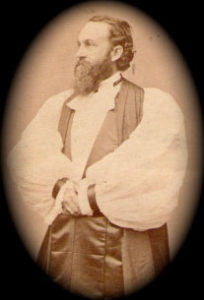Patrick Ronayne Cleburne

(March 17, 1828 – November 30, 1864) was an Irish-born American soldier, best known for his service in the Confederate States Army during the American Civil War, where he rose to the rank of major general.
Born in County Cork, Ireland, Cleburne served in the 41st Regiment of Foot, a Welsh regiment of the British Army, after failing to gain entrance into Trinity College of Medicine in 1846. He immigrated to the United States three years later. At the beginning of the Civil War, Cleburne sided with the Confederate States. He progressed from being a private soldier in the local militia to a division commander. Cleburne participated in many successful military campaigns, especially the Battle of Stones River, the Battle of Missionary Ridge, and the Battle of Ringgold Gap. He was also present at the Battle of Shiloh. His strategic ability gained him the nickname “Stonewall of the West”. He was killed in 1864 at the Battle of Franklin.
Leonidas Polk

(April 10, 1806 – June 14, 1864) was a bishop of the Episcopal Diocese of Louisiana and founder of the Protestant Episcopal Church in the Confederate States of America, which separated from the Episcopal Church of the United States of America. He was a slaveholding planter in Maury County, Tennessee, and a second cousin of President James K. Polk. He resigned his ecclesiastical position to become a major general in the Confederate army when he was called “Sewanee’s Fighting Bishop”. His official portrait at the University of the South depicts him dressed as a bishop with his army uniform hanging nearby.
He is often erroneously referred to as “Leonidas K. Polk”, but he had no middle name and never signed any documents as such.
Polk was one of the more notable, yet controversial, political generals of the war. Recognizing his indispensable familiarity with the Mississippi Valley, Confederate President Jefferson Davis commissioned his elevation to a high military position regardless of his lack of prior combat experience. He commanded troops in the Battle of Shiloh, the Battle of Perryville, the Battle of Stones River, the Tullahoma Campaign, the Battle of Chickamauga, the Chattanooga Campaign, and the Atlanta Campaign. He is remembered for his bitter disagreements with his immediate superior, the likewise-controversial General Braxton Bragg of the Army of Tennessee, and for his general lack of success in combat. While serving under the command of General Joseph E. Johnston, he was killed in action in 1864 during the Atlanta Campaign.
Charles Todd Quintard

(December 22, 1824 – February 15, 1898) was an American physician and clergyman who became the second bishop of the Episcopal Diocese of Tennessee and the first Vice-Chancellor of the University of the South.
Medical career
He was born in Stamford, Connecticut, to a Huguenot-descended family and attended school in New York City, including medical studies at University Medical College, New York University and Bellevue Hospital, graduating in 1847. Quintard moved to Athens, Georgia, in 1848 to take up a medical practice, then moved to Memphis in 1851 to teach physiology and pathological anatomy at Memphis Medical College. Dr. Quintard’s 1854 report on Memphis mortality statistics was covered in The New York Times, including his assessment of the city as being “the first considerable place to be without the range of yellow fever,” a boast that was to prove incorrect in the 1870s, when Memphis experienced several yellow fever epidemics.
Priesthood
During this time, Quintard became friends with James Hervey Otey, the first bishop of the Episcopal Diocese of Tennessee, resulting in his decision to give up the medical profession for the priesthood. A gentleman of great talents, Quintard studied for holy orders in 1854, was ordained deacon on January 1, 1855, and priest on January 6, 1856. He subsequently served as the rector of Calvary Church in Memphis and at the Church of the Advent in Nashville.
An adherent of the Oxford Movement (1833-1845), Quintard described himself as a “high churchman” and a “ritualist”, identifying with Anglicans who were reviving ritual practices associated, in the popular mind, with Roman Catholicism.[4] In fact, the Oxford Movement leaders attempted to call the Anglican Church to her first principles and roots in history and tradition. To what degree Quintard was actually a Ritualist is a matter to debate. None of the Tractarians was a “ritualist,” and the ritualism that developed in the Episcopal Church in the South was rather tame during Bishop Quintard’s lifetime. Like Bishop Otey, he was of the Southern branch of the old High Church or Hobartian group of Episcopalians. The leaders of the Oxford Movement also called “Tractarians” for the ninety Tracts for the Times they published, rediscovered the Church of the Creed as more than an institution or an arm of civil power. Quintard and his generation were deeply moved by the writings of faithful and brilliant Christian intellectuals such as John Keble (d. 1866), Edward Pusey (d. 1882), and John Henry Newman (d. 1890), who guided many Anglicans into a deeper appreciation of the Church as a God-made phenomenon and indeed the Body mystical of Christ in this world. Quintard’s religion was as “Catholic and Reformed” most solid Anglicans, and he assumed in a manner that did not transcend his culture that the Church of England and her offspring were in fact the historic Catholic Church for English-speaking peoples.
Civil War
After the outbreak of the American Civil War, Quintard joined the Rock City Guards, a Nashville militia, as a chaplain. He was subsequently nominated by soldiers in the Confederate 1st Tennessee Infantry Regiment, to serve as their chaplain. He accepted this invitation, despite his initial pro-Union stance, and also served as a regimental surgeon. Informally he was known as the Chaplain of the Confederacy. He was the compiler of the Confederate Soldiers’ Pocket Manual of Devotions (Charleston, 1863). In 1864, he organized St. Luke’s Episcopal Church in Atlanta.
The South’s first post-war bishop
Bishop Otey died in 1863, but the Diocese of Tennessee was unable to elect a new leader until after the war, on September 7, 1865, when it selected Quintard as its second bishop. The bishops and lay leaders of the national Episcopal Church confirmed his election the next month at the General Convention in Philadelphia. The subsequent consecration of the South’s first post-war bishop was viewed as a sign of healing within the church, as evidenced by this comment on October 13, 1865, New York Times:
The entire service was one to be long remembered by all who witnessed it, and the occasion was one fraught with interest and importance in the history of the Church, as it marked the first step toward that reunion in the Church consequent upon the rapid march of events and the peace which now happily blesses our whole land. It is to be hoped that the occasion will strengthen that harmony which prevails in the convention, and be productive of beneficial results.
Quintard received honorary doctorates from Columbia College (Doctor of Divinity, 1866) and Cambridge (Doctor of Laws, 1867).
Stewardship of The University of the South in Sewanee, Tennessee
Quintard quickly launched rebuilding efforts in his diocese, which had suffered much physical and emotional distress during the war. He also led efforts to ensure the post-war survival of the fledgling University of the South at Sewanee, Tennessee. As the school’s vice-chancellor (the institution’s chief executive position, despite the name) Quintard sponsored the establishment of a training school for the clergy there in 1866 and laid the cornerstone for St. Augustine’s Chapel in 1867. He traveled to the northern U.S. diocese to raise funds for the university and went to England three times with the same purpose, returning with large sums of money and many books for the school’s library.
Quintard Hall at the university was given by his brother George W. Quintard in 1900. Until 1908 it was the site of the grammar school, and from then until 1971 it was used by the Sewanee Military Academy. It is now a co-ed residence hall for the university. The University of the South remains an Episcopal institution and is a nationally admired center of liberal education. The Sewanee Review (1892) is the oldest continuously published literary journal in the U.S., and the ideal of “Godliness and good learning” is alive and well in a very special place, Quintard consecrated with his prayers and deepest wishes.
Death and legacy
Quintard died in February 1898 in Meridian, Georgia, having traveled and stayed there in an effort to improve his health. Quintard is honored with a feast day on the liturgical calendar of the Episcopal Church in the United States of America on February 16.
